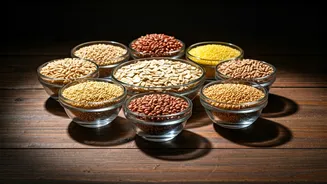Embracing a Dietary Shift
Managing diabetes often involves lifestyle changes, and among these, dietary modifications play a pivotal role. The choice of grains significantly influences
blood sugar levels, making it crucial to select those that help rather than hinder. The approach described in this article provides insights into grains that can support stable blood glucose levels and promote long-term well-being. Focusing on whole grains and understanding their impact is a step towards a healthier lifestyle.
The Power of Oats
Oats stand out as an excellent grain choice for individuals with diabetes. They are high in soluble fiber, which helps slow down the absorption of sugar into the bloodstream, thus preventing sudden blood sugar spikes. Oats are also known for promoting satiety, aiding in weight management, which is often a key aspect of diabetes care. Whether consumed as oatmeal for breakfast or added to other meals, oats provide both nutritional value and support blood sugar control.
Barley's Beneficial Impact
Barley is another grain that offers significant benefits for people with diabetes. Similar to oats, barley is rich in fiber that helps manage blood sugar levels. Incorporating barley into the diet can lead to improved insulin sensitivity, allowing the body to use insulin more effectively. Barley can be used in soups, salads, or as a side dish, adding both nutrition and a pleasant texture to the meals. This versatility makes it easy to integrate into various dietary preferences.
Quinoa's Nutritional Profile
Quinoa is a complete protein source, offering all nine essential amino acids, making it a valuable addition to any diet, particularly for individuals with diabetes. Unlike many grains, quinoa has a low glycemic index, meaning it causes a slower and steadier rise in blood sugar levels. It’s also gluten-free, appealing to those with gluten sensitivities. Quinoa is easily prepared and can be included in salads, bowls, or as a substitute for rice, providing a nutritious and versatile option.
Brown Rice Advantage
Brown rice provides a healthier alternative to white rice for diabetics due to its higher fiber content. Fiber slows down the digestion and absorption of carbohydrates, preventing sharp increases in blood sugar. It also offers essential nutrients such as magnesium and selenium, which are beneficial for overall health. Choosing brown rice over white rice is a simple, yet impactful change that can significantly improve blood sugar management.
The Goodness of Buckwheat
Despite its name, buckwheat is not a wheat variety, making it a gluten-free option for many. It has a low glycemic index and is a good source of fiber, which helps in managing blood sugar. Buckwheat can be used to make pancakes, noodles (soba), or as a porridge. Its unique flavor and texture make it an interesting addition to the diet, and its nutritional benefits make it especially suitable for individuals with diabetes, supporting stable blood sugar levels.
Millet for Diabetes Control
Millet is a versatile and nutrient-rich grain that can play a positive role in managing diabetes. It has a low glycemic index and is rich in fiber, which helps regulate blood sugar. Including millet in the diet can improve insulin sensitivity and support weight management. Millet can be used in various forms, such as porridge, and can be incorporated into different meals to provide a beneficial dietary option for diabetics.
Whole Wheat Benefits
Whole wheat, when consumed in moderation, can be a part of a diabetes-friendly diet. The key is to choose whole wheat products over refined versions. Whole wheat provides fiber, which slows down the absorption of glucose. This reduces the risk of rapid blood sugar spikes. It also offers essential nutrients, making it a more nutritious choice than white bread or pasta. It's a key to focus on portion control when including this grain in your meal plan.
The Role of Amaranth
Amaranth, another gluten-free grain, is packed with nutrients and has a low glycemic index. It’s a complete protein and contains important minerals such as magnesium. These factors combine to make amaranth a valuable addition to a diabetic diet. It can be used as a porridge, added to salads, or even popped like popcorn. Its nutritional profile and versatile nature support overall health and blood sugar management.
Incorporating Rye Grain
Rye grain is a nutritious option that offers benefits for those with diabetes. It provides a good source of fiber, which aids in blood sugar regulation by slowing the absorption of glucose. Additionally, rye often has a lower glycemic index compared to wheat, which helps in managing post-meal blood sugar levels. Rye can be used in bread, crackers, or even in breakfast cereals, which adds flavor and variety to your diet, while also supporting stable blood sugar.











